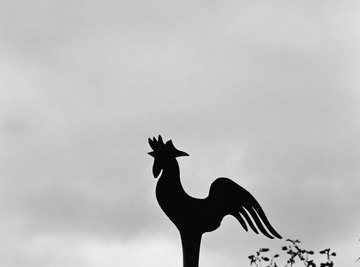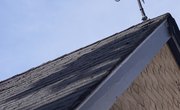
Before the days of round-the-clock weather stations and forecasts at your fingertips, people had to rely on more basic means of measuring wind and predicting weather. Early farmers and sailors looked to wind vanes to detect wind direction, while the introduction of the anemometer helped to reveal information about wind speed and pressure. Despite the introduction of satellites and other forecasting technologies, both weather vanes and anemometers remain simple and effective tools to help you learn about the wind.
Wind Vane History
The traditional wind vane ranks among the oldest weather measurement tools ever introduced. Around 48 B.C., a large wind vane in the form of Triton, god of the sea, sat atop the Tower of the Winds in Athens. In the ninth century, Viking sailors used quadrant-shaped wind vanes to help them safely navigate the seas. Around the same time period, Pope Nicholas I decreed that all European churches should be adorned with a rooster-shaped wind vane. By the Middle Ages, wind vane designs were inspired by the flags used to judge wind direction in archery, and many featured an arrow-shaped pointer ending in a banner or flag shape. Modern wind vanes typically take the form of animals, horses, sporting events or humorous subjects.
Anemometer History
The anemometer came much later than the earliest weather vanes. In 1450, Italian architect Leon Battista Alberti developed an anemometer in the form of a disk that was oriented perpendicular to the wind. Around 1846, John Robinson of Ireland created the cup-style anemometer that is so common today. His device interacted with a series of wheels to reveal wind speed in revolutions per unit of time. In 1994, Dr. Andreas Pflitsch created the sonic anemometer, which relied on sound waves to accurately detect wind speed.
Wind Vane Function
The wind vane consists of a horizontal rod that spins freely around a fixed vertical rod. This horizontal member features equal weight on both sides of the vertical rod, but one side is much larger so that it will catch the wind. The smaller side of the horizontal rod points directly into the wind to indicate wind direction. For example, the rod would point to the north to indicate a north wind, which means that the wind is blowing from the north to the south. Traditional wind vanes offer no other function beyond pointing out the direction of the wind.
Anemometer Function
Anemometers measure wind speed rather than direction. The most common style of anemometer uses a series of three or four cups that are positioned around a fixed vertical rod. As the cups catch the wind, they spin around the rod; the faster the wind blows, the faster the cups will rotate around the rod. Propeller-style units often resemble an old-fashioned airplane with a propeller at one end and a rudder-like tail. These units combine an anemometer and wind vane into one single device to measure speed and direction. Hot-wire anemometers consist of an electrically heated wire placed in the wind. By measuring the amount of power needed to heat the wire, this device can provide information on wind speed. Finally, tube anemometers feature a simple open-ended tube placed into the wind. By comparing air pressure within the tube to air pressure outside the tube, users can measure wind speed.
Uses
Thanks to modern technology, wind vanes now serve a largely decorative function, according to National Geographic. These devices still serve as simple and effective means of positioning a wind turbine in the best location to capture the wind, for example, or to help guide a sailboat.
Anemometers, on the other hand, can still be found on weather stations around the world. Physicists and other scientists also use these devices for testing purposes. For example, an anemometer may provide information on wind speed around a moving car or aircraft. Wind turbine sellers and related organizations lend or rent anemometers to potential customers to help them determine if wind speeds are sufficient to power a turbine on their land.
References
About the Author
Emily Beach works in the commercial construction industry in Maryland. She received her LEED accreditation from the U.S. Green Building Council in 2008 and is in the process of working towards an Architectural Hardware Consultant certification from the Door and Hardware Institute. She received a bachelor's degree in economics and management from Goucher College in Towson, Maryland.
Photo Credits
Hemera Technologies/AbleStock.com/Getty Images
